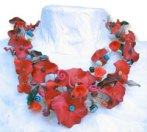Friesen’s TP trick

The armature for Christi Friesen’s latest wrap vessels may make you smile. She uses a ball of wet toilet paper!
Christi reveals that, “The technique is simply to take some toilet paper, get it wet, wad it into a ball and wring out the excess water. Wrap the clay around the ball and sculpt! The paper provides firmness to work against so you’re not poking through the vessel when you try to add details. Once the vessel is baked, just submerge the pot in water until the toilet paper gets all dissolvey. Then pull it out. It’s fun.”
Her new vessels will be in the next issue of American Style magazine and her annual eBay sale is happening this week.















